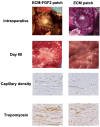Bridging the Gap: Advances and Challenges in Heart Regeneration from In Vitro to In Vivo Applications
- PMID: 39451329
- PMCID: PMC11505552
- DOI: 10.3390/bioengineering11100954
Bridging the Gap: Advances and Challenges in Heart Regeneration from In Vitro to In Vivo Applications
Abstract
Cardiovascular diseases, particularly ischemic heart disease, area leading cause of morbidity and mortality worldwide. Myocardial infarction (MI) results in extensive cardiomyocyte loss, inflammation, extracellular matrix (ECM) degradation, fibrosis, and ultimately, adverse ventricular remodeling associated with impaired heart function. While heart transplantation is the only definitive treatment for end-stage heart failure, donor organ scarcity necessitates the development of alternative therapies. In such cases, methods to promote endogenous tissue regeneration by stimulating growth factor secretion and vascular formation alone are insufficient. Techniques for the creation and transplantation of viable tissues are therefore highly sought after. Approaches to cardiac regeneration range from stem cell injections to epicardial patches and interposition grafts. While numerous preclinical trials have demonstrated the positive effects of tissue transplantation on vasculogenesis and functional recovery, long-term graft survival in large animal models is rare. Adequate vascularization is essential for the survival of transplanted tissues, yet pre-formed microvasculature often fails to achieve sufficient engraftment. Recent studies report success in enhancing cell survival rates in vitro via tissue perfusion. However, the transition of these techniques to in vivo models remains challenging, especially in large animals. This review aims to highlight the evolution of cardiac patch and stem cell therapies for the treatment of cardiovascular disease, identify discrepancies between in vitro and in vivo studies, and discuss critical factors for establishing effective myocardial tissue regeneration in vivo.
Keywords: 3D printing; cardiac regeneration; heart tissue; microvasculature; paracrine effect; transplantation; vascularization.
Conflict of interest statement
The authors declare no conflicts of interest.
Figures



Similar articles
-
Expandable human cardiovascular progenitors from stem cells for regenerating mouse heart after myocardial infarction.Cardiovasc Res. 2020 Mar 1;116(3):545-553. doi: 10.1093/cvr/cvz181. Cardiovasc Res. 2020. PMID: 31287499 Free PMC article.
-
A collagen hydrogel loaded with HDAC7-derived peptide promotes the regeneration of infarcted myocardium with functional improvement in a rodent model.Acta Biomater. 2019 Mar 1;86:223-234. doi: 10.1016/j.actbio.2019.01.022. Epub 2019 Jan 16. Acta Biomater. 2019. PMID: 30660010
-
Alignment of inducible vascular progenitor cells on a micro-bundle scaffold improves cardiac repair following myocardial infarction.Basic Res Cardiol. 2017 Jul;112(4):41. doi: 10.1007/s00395-017-0631-4. Epub 2017 May 24. Basic Res Cardiol. 2017. PMID: 28540527
-
Dietary glycation compounds - implications for human health.Crit Rev Toxicol. 2024 Sep;54(8):485-617. doi: 10.1080/10408444.2024.2362985. Epub 2024 Aug 16. Crit Rev Toxicol. 2024. PMID: 39150724
-
Role of Biomaterials in Cardiac Repair and Regeneration: Therapeutic Intervention for Myocardial Infarction.ACS Biomater Sci Eng. 2022 Aug 8;8(8):3271-3298. doi: 10.1021/acsbiomaterials.2c00454. Epub 2022 Jul 22. ACS Biomater Sci Eng. 2022. PMID: 35867701 Review.
Cited by
-
Injectable Stem Cell-Based Therapies for Myocardial Regeneration: A Review of the Literature.J Funct Biomater. 2025 Apr 23;16(5):152. doi: 10.3390/jfb16050152. J Funct Biomater. 2025. PMID: 40422817 Free PMC article. Review.
-
Nanoparticle-assisted targeting of heart lesions with cardiac myofibroblasts: Combined gene and cell therapy.Theranostics. 2025 Mar 18;15(10):4287-4307. doi: 10.7150/thno.103816. eCollection 2025. Theranostics. 2025. PMID: 40225585 Free PMC article.
References
-
- Lund L.H., Edwards L.B., Kucheryavaya A.Y., Benden C., Christie J.D., Dipchand A.I., Dobbels F., Goldfarb S.B., Levvey B.J., Meiser B., et al. The registry of the International Society for Heart and Lung Transplantation: Thirty-first official adult heart transplant report—2014; focus theme: Retransplantation. J. Heart Lung Transplant. 2014;33:996–1008. doi: 10.1016/j.healun.2014.08.003. - DOI - PubMed
-
- Mozaffarian D., Benjamin E.J., Go A.S., Arnett D.K., Blaha M.J., Cushman M., Das S.R., de Ferranti S., Despres J.-P., Fullerton H.J., et al. Heart Disease and Stroke Statistics-2016 Update: A Report From the American Heart Association. Circulation. 2016;133:e38–e360. doi: 10.1161/CIR.0000000000000350. - DOI - PubMed
Publication types
Grants and funding
LinkOut - more resources
Full Text Sources
Miscellaneous

